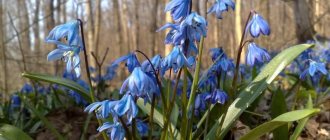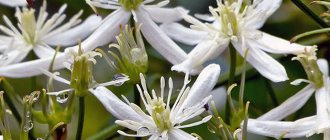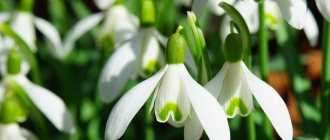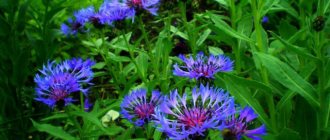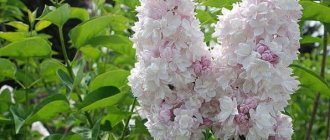Author: Natalya Category: Garden plants Published: February 14, 2019Republished: February 14, 2019Last edits: November 03, 2020
- Growing conditions
- Bellflower (Scilla hispanica)
Scilla (lat. Scilla) belongs to the genus of bulbous perennials of the Asparagus family, although previously it was part of the Hyacinth or Liliaceae family. Another name for Scylla. Sometimes the woodleaf is confused with the woodleaf or snowdrop. The genus includes about 90 species of plants living in mountain meadows and plains of Asia, Africa and Europe. The scylla plant gets its name from the Greek name for sea onion, skilla, which used to belong to this genus. Scilla flowers are distinguished by their high decorativeness and frost resistance, resistance to disease and the ability to adapt to any conditions.
Scylla planting: when, how and where to plant?
Often, novice flower growers are faced with problems: the timing of planting scylla, finding a suitable area for planting scilla, and difficulties with care. However, growing Scylla will not be difficult, the main thing is to follow basic rules of care and planting technology.
Scylla has about 20 species, but for any variety of scilla, the optimal set of growing conditions described below is suitable.
Scylla is a photophilous plant, winter-hardy and unpretentious, like all small-bulbous plants. It does not require annual digging and replanting, storage outside the soil and abundant watering. In order for the scilla to develop and bloom profusely, it is enough to simply choose the most comfortable place for it.
When choosing a site for planting scylla, pay attention to a windless and sun-warmed place with variable solar activity.
Since Scylla is still a “forest flower,” it prefers light, enriched soil with good aeration. A place under trees or near bushes is quite suitable.
Scylla reacts negatively to acidic and swampy soils and does not tolerate heavy soils. If the soil on your site does not meet the basic requirements for growing plants, you can always enrich it with peat and compost, drain it with sand and green manure, and apply acidic lime.
Planting spring scylla in open ground, like all small-bulbous plants, should be done in the fall. And varieties of blueberries that bloom in summer and autumn should be planted a month and a half before the expected flowering. Scilla gets along well with other spring flowers; in the flowerbed it gets along with all representatives of the plant world, and if snowdrops or crocuses are planted between the scylla, bright contrast and admiring glances will be guaranteed to your site.
Scylla reproduces vegetatively and by seeds, forming both a seed pod after flowering and children. If you decide to sow scylla, keep in mind that flowering will not occur until the flower forms a viable bulb.
Scylla seeds are sown in the spring, in warm soil, so that by winter the seedlings will sprout and gain strength for the winter. Sowing is carried out to a depth of 6-8 cm; with this planting scheme, the scilla will begin to bloom no earlier than in 3-4 years.
Reproduction by children occurs differently; during the growing season, the mother bulb forms a separate small bulb about 0.5-1 cm, which after a year is ready for planting in a new place.
Scylla babies are transplanted a year after formation, carefully separating them from the mother bulb and placing them in prepared holes up to 8 cm deep.
Planting scylla in open ground
What time to plant
Planting and growing scilla is quite simple. These flowers are usually used to decorate borders, rockeries, alpine slides and mixborders. Also incredibly impressive are the trunk circles of garden trees, which in early spring are decorated with beautiful Scylla flowers. You can plant such a plant even during the flowering period. However, experts recommend planting spring-flowering scylla after the leaf blades die off (from mid-June), and those that bloom in the spring - 4 weeks before the formation of flower stalks. These flowers prefer well-lit areas, but they can also be grown in shaded areas. It should be taken into account that autumn-flowering species are not as light-loving as compared to those that bloom in the spring.
Landing Features
Before proceeding with the actual planting of scylla, it is necessary to prepare the area. Such a plant will grow best in soil with a large amount of organic matter, which includes mineral components and leaf humus. In order for these flowers to grow and develop perfectly, it is recommended to mix garden soil with forest soil, which contains semi-decomposed tree bark and foliage. Suitable soil acidity should be between 6.5 and 7.0.
Between planting holes it is necessary to maintain a distance of 5 to 10 centimeters. The bulbs should be buried 6–8 centimeters into the soil (depending on the size of the planting material).
Scillas. How to plant a plant?
How to care for Scylla? Proper care is the key to a successful gardener
Scylla is an unpretentious plant that does not require painstaking care. Scilla is resistant to low temperatures, tolerates short-term frosts, and is not susceptible to diseases of garden flowers (with the exception of root rot).
However, you should not let any flowering process in your area take its course. For bright and abundant flowering, the scilla needs watering and fertilizing, like any other self-respecting plants.
Watering should be rare, but plentiful, and at the beginning of the growing season it is not necessary at all, the abundance of snow will do its job and provide water to the woodland. Overmoistening is detrimental for the scylla flower, as it can cause rotting of the bulb and death of the plant, so make sure that the water in the area does not stagnate and organize drains in a timely manner, and to prevent stagnation of water, before the snow melts, clear the area of snow cover.
If your soil on the site is depleted, apply phosphorus-potassium fertilizers, nitrogen, compost, and ammonium nitrate. This should be done during flowering and before the plant produces its first flower stalk. The main thing is to avoid burns, fertilizer should be applied at the root, without spilling on the flower.
Scylla does not need hilling, and the weeds have not yet appeared, so hand weeding is carried out as the weed grows.
If you do not want the scylla to grow exponentially, taking over the entire area, it is better to pick off the seed pods immediately, as they arise.
After flowering, dried peduncles and leaves are cut off, and in late autumn, in late autumn, the area with scylla plantings is covered with mulch or spruce branches to avoid freezing of the soil and bulbs.
Growing scylla for the New Year and March 8
Planting scylla for the holiday depends on when you need to receive flowers. The period of calm for the bulbs is 8 weeks. Therefore, if you need to drive out a plant for the New Year, then plant the bulbs in September. If by March 8 - in November.
The bulbs are planted in pots with a diameter of approximately 10-15 cm. Plant 2-3 pieces each. Then the pots are removed to a dark, cool place (from 0 to +5).
Before you need to get flowers, about 2-3 weeks, the pots are taken out to light and warmth. The place for them should be well-lit and warm, but not hot (up to +15 - +18 degrees). Moderate watering is necessary: the soil should not be excessively wet, but it should not be allowed to dry out. Within a week, leaves will appear, and soon the scylla will bloom.
Scylla is a wonderful, delicate, unpretentious flower. Blue flowers will bring joy when everything around is still gloomy and gray. The leaves on the trees have not yet blossomed, and even the snow has not completely melted, but the scilla is already blooming and captivating with its honey aroma.
Scylla "Siberian" or Scylla "Sibirica"
This species bears its name “in absentia”, since Siberia is not the birthplace of the Siberian species, but it grows in the south of Russia and in Europe.
The difference between the “Siberian” scylla is the soft blue hue of the medium-sized flowers. The peduncle is thin, up to 20 cm in height. “Siberian” scilla exudes a light, pleasant aroma. Subspecies of "Sibirika" are:
Caucasian Scylla, growing in the Caucasus. The flowers of the plant are dark blue or violet-blue. The leaves are linear up to 15 cm in length. Flowering lasts about three weeks.
Armenian Scylla, growing in the Caucasus, Turkey and Armenia. It has linear curved leaves, blue flowers of medium size up to 2 cm.
It blooms from April to May, grows quickly, covering the area with a continuous carpet.
The “Siberian” species also has a “Siberian subspecies”, the distinctive feature of which is its growth (it grows in Asian countries and central Russia) and the classic, milky shade of the inflorescences. The subspecies of Siberian scylla blooms somewhat later than the others, and has varieties of shades from milky to pale pink.
The most popular and well-proven varieties of Siberian scylla are:
The Spring Beauty variety, with large bulky purple flowers, and the Alba variety, with white flowers.
Botanical description
The perennial blueberry has a small, rounded bulb. The outer scales are brown with a purple tint. The leaves grow from the bulbous neck at the same time as the flowers, which are located on long, smooth peduncles. The inflorescences resemble an artist's brush and are slightly flattened on the sides.
The scylla flower is a good honey plant, and it is often visited by insects, due to which pollination takes place. The leaf plates have their own peculiarity, and on rainy days they press against the ground. When the weather is sunny, the leaves rise vertically. After the flowers are pollinated, a seed capsule ripens, containing irregularly shaped dark-colored seeds.
Scilla is a primrose that blooms its delicate flowers as soon as the snow melts. The rest of the time, starting from the first days of summer, the flower is in the dormant stage. That is, its entire above-ground part dies off until next spring. This biorhythm is repeated annually, and the plant lives in one place for more than 12 years.
Scilla flowers in the photo:
Scylla "Peruvian"
"Peruvian" scylla is a common species of perennial mellubbous plant of the Asparagus family. The Peruvian species of scylla, like the Siberian one, got its name by accident. Scylla bulbs were brought from Spain in 1750, on a ship called Peru, from which time Scylla got its name “Peruvian”.
A distinctive feature of the Peruvian species is a high peduncle, linear erect leaves 30 cm long, blue flowers collected in racemes of 30-60 pieces.
The flowering of the "Peruvian" scylla extends from May and continues in some areas until June. The homeland of the Peruvian species is Spain, Portugal, the Canary Islands, Sicily and Malta. The purpose of the Peruvian scylla is decorative; it is often used for landscape decorations and in the design of flower beds.
Scylla "bell-shaped" (Endymion Hispanica)
The "bell-shaped" scylla or "Spanish endymion" originates from the forests of Spain, Portugal and France. The plant can be considered one of the most beautiful species of scilla.
A medium-sized peduncle is decorated with blue or pink flowers, in the form of a large bell 2-3 cm in size. There can be up to 8 flowers on one peduncle, making up a marvelous “fluffy” bunch.
The bell-shaped scylla begins flowering at the end of May and ends in June. The variety of bell-shaped varieties cannot but please the eye and delight gardeners.
The most popular varieties of bell-shaped scylla are:
Sky Blue, a variety with large sky-blue flowers and blue veins located on large peduncles.
Rose Queen, a vibrant variety with pink flowers and lavender undertones.
La Gradence will surprise you with its large white flowers, collected in lush clusters, and a delicate aroma.
Rosabella, pink-lilac flowers in inflorescences, will fill the garden with fragrance. Plant height is up to 25 cm. The variety is in demand among florists and landscape designers.
In addition to those described above, the bell-shaped scylla includes scillas of the following varieties: Everest, Blue Pearl, Blue Queen, Blue Giant, Queen Pinks and others.
Scylla "Spanish"
Scylla spanisha or Hyacinthoides spanisha is native to Spain and is a perennial bulbous member of the hyacinth family.
Botanically, it is similar to scilla, but is a representative of a different group of plants. In early autumn it produces lanceolate basal leaves, about 25 cm long, then a peduncle. The bulb is light, irregular oval in shape, from 2 cm in diameter.
Flowering begins from late April to May, approximately two and a half weeks. The flowers are bell-shaped, bulky, pale blue or deep purple, and come in milky or pale pink. Inflorescences can consist of about 10 flowers collected in racemes.
When the Spanish blueberry fades, the leaves gradually turn yellow and dry out, and new bulbs form in the ground. After the leaves dry completely, moisturizing is completed, as the plant is preparing for wintering. Spanish scilla is perfect for growing in open ground (in autumn, purchased bulbs can simply be buried in the ground to a depth of 8 cm), the plant tolerates cold weather.
Pests and diseases of the Scilla flower
It is worth noting that the Scylla flower is quite resistant to various diseases, but some diseases caused by improper care are still inherent in it.
Thus, an abundance of moisture in the soil can lead to the appearance of fungal infections, which will result in rotting of the bulbs. The first signs of the disease are yellowing of the foliage and drying out of the peduncle. By affecting the bulb, the disease leads to the death of the flower.
Dead flowers must be burned and the soil treated with a fungicide. Only after treatment is the soil suitable for subsequent planting.
Scilla flower can also be affected by root mite, the larvae of which grow inside the bulb. You can combat plant infestation with mites by treating the soil with an insecticide. The mulch used to cover the planting should also be disinfected before spreading the soil.
In garden conditions, tubers can suffer from mice that feast on the rhizome. You can prevent rodents by planting tubers in special metal bags. They go deep into the ground when planting bulbs and serve as reliable protection against mice.
“Two-Leaf Scilla”
Scylla bifolia grows in the Mediterranean, Crimea, and the Caucasus. A low-growing variety of Scylla bifolia blooms profusely and luxuriantly, not wasting energy on “extra greenery”, but investing it in the cap of the peduncle.
The height of the plant reaches 15 cm, has up to three peduncles, with white and pink inflorescences. Bifolia scylla has two wide basal, linear leaves. The two-leaved scylla includes in its group the purple scilla, which has bright purple flowers. It blooms for about two weeks.
“Autumn Scilla”
An autumn species of scylla, found in the mountains of the North Caucasus and Asia Minor. The plant can reach 22 cm in height. It blooms from August to September with small dark lilac or purple flowers. The clusters of inflorescences are sparse, containing from 3 to 15 flowers.
The variety of scylla does not end with the varieties described above; the cultivated variety of the plant includes grape scylla, pushkiniformes, Italian, Bukhara, Chinese, one-flowered and Mishchenko's scilla.

